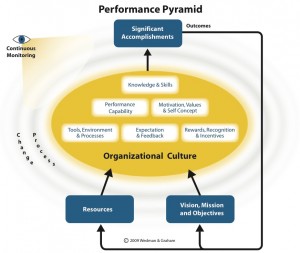Hello. I’m John Wedman, an administrator at the University of Missouri and former business owner. One of our business services was evaluating corporate training programs. Not surprisingly, some programs fell short of producing the desired results. Was the training lacking or was something else going on?
Answering that question led us to develop the Performance Pyramid, a framework and process for identifying, analyzing, and addressing the barriers to optimal performance in the workplace. The Pyramid is particularly helpful when conducting Level 4 evaluations where the focus is on results – the effects on the organization resulting from trainee performance.
The Performance Pyramid is based on the premise that, in order to accomplish something of significance, Vision, Resources, and Support System must be in place and aligned. As shown in the model, the organizational culture influences the support system. When the three major elements and the six support system blocks are adequate and aligned, and the change process is managed and monitored, goals can be achieved.
Hot Tips:
When a Level 4 evaluation indicates trainee performance in not having the desired effects, the Pyramid can guide efforts to find out why. Here are a few tips to help with the search. While the tips use a “new distance learning software platform” as an example, the tips can be applied to any performance improvement context.
- The relative position of the Pyramid’s six Support System blocks is arbitrary; no one block is necessarily more important than another. For example, Knowledge & Skills related to using a new distance learning software platform are NOT more important than the Tools, Environment & Processes associated with the platform.
- Each of the six blocks must be in place in order to achieve the desired outcomes. For example, if some instructors are not told they are using the new platform in a way that is inconsistent with the instructional approach adopted by the organization, Expectations & Feedback are not adequate.
- The inter-relationship among the blocks is critical. For example, if a training program focuses on learning the new platform, but the new platform is more time and labor intensive than the old platform, there is a misalignment between Knowledge & Skills and Rewards, Recognition & Incentives.
- The support system blocks are individually and collectively influenced by the organizational culture. To illustrate, if the organization highly values instructor autonomy, the culture will hinder efforts to create a more predictable distance learning experience across all courses. We all know the adage – “Culture eats strategy for breakfast every day.”
- Finally, if a Level 4 evaluation indicates the effects on the organization are not as desired, it is quite likely Expectations have not been effectively communicated, and Feedback is sporadic and uninformative.
For more information about the Performance Pyramid and a free copy of the Pyramid Guide, please visit here.
Do you have questions, concerns, kudos, or content to extend this aea365 contribution? Please add them in the comments section for this post on the aea365 webpage so that we may enrich our community of practice. Would you like to submit an aea365 Tip? Please send a note of interest to aea365@eval.org. aea365 is sponsored by the American Evaluation Association and provides a Tip-a-Day by and for evaluators.


Pingback: Critical Elements of Performance Sucess | Read on Learning
Is this Lynch and Cross Performance pyramid framework into action?
I find it quite different from the one L&C pyramid.
However, there are some consistency.
Pingback: The Performance Pyramid « sean f burns
Really liked this and I just ordered my free guide!